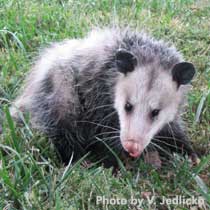Living With Wildlife
This section discusses enhancing your acreage to attract wildlife and preventing wildlife damage.

Diversity is the Key to Attracting Wildlife
-
Plant as many different types of grasses, forbs, shrubs and trees as possible.
-
Select a diverse range of varieties of each type of plant.
-
Have many sources of water. Ponds, swamps, bogs and bird baths are all great sources of water for wildlife. Place water sources in open and hidden locations.
-
Take advantage of the fact that many animals prefer the edge where two different types of habitats meet. Form as much " Edge Effect" as you can.
Consider the following. . .
Do you have a large diversity of vegetation on the property?
Do you have accessible year-round water sources in various locations?
Are there dead trees, brush piles or rock piles scattered across the landscape?
Is year-round food provided for a diverse planting of grasses, shrubs and trees?
Do you supplement food resources for wildlife?
Master Plan
- Find out what species of wildlife are native to your area.
- Decide which of the native wildlife you would like to manage.
- Learn as much as possible about the requirements of those species.
- Determine habitat enhancement needs on your property.
- Design short- and long-term plans for habitat improvements.
Design Guidelines
- Select plants that provide cover and food.
- Plant a variety of plant types; intersperse, creating a mixed stand.
- Plant to create protected nesting areas.
- Plant in locations that form corridors or connections between different larger habitat plantings.
- Promote and plant woodland, grassland, riparian and wetland habitats.
- Create a number of each type of habitat so different habitat are adjacent, forming as many " edge" areas as possible.
Grassland Habitat Hints
- Grasslands are made up of many grasses, legumes and forbs.
- Mix as many species of native grassland species as possible.
- Do not plant grasslands uniformly, but make them patchy to create a mosaic effect.
- Many animal species need a large unbroken prairie area.
- Maintain grasslands by eliminating any woody plants (especially cedars).
- Add water by forming small " prairie potholes" in low areas. Incorporate a small clay seal in the soil of the lowest point.
- Allow piles of dead grasses and forbs to remain through the winter. These become important overwintering cover.
- Control introduced noxious weed species.
Wetland/Riparian Habitat Hints
- True wetland or riparian habitats are very difficult to create where the natural components do not exist.
- Where wetland habitats exist, protect them from draining and pollution. Manage for natural wetland plants and prevent their destruction.
- If a creek or stream transects the property, allow at least 50 feet on each side for a riparian habitat strip. Plant trees and shrubs that provide food, cover and prevent erosion. Many tree species are adapted to riparian locations.
- Use riparian habitats to connect other types of habitats.
- Consider trying to create wetlands as well as ponds. Establish large shallow areas around ponds with cattails and wetland grasses.
Woodland Habitat Hints
- Mix evergreen, deciduous and shrub species. Plant in random groupings.
- Select species that provide food for wildlife, forage, nuts, fruits and seeds.
- Select plants that are different heights. Some will give canopy habitat while others form lower habitat cover.
- Allow dead trees to stand if they are in an area that is non-threatening to humans or property. These provide nesting for many wildlife species.
- Fallen trees also form good cover.
- Snags or piles of brush are perfect overwintering sites.
- Create dead trees by girdling live ones and shelter by stacking cut branches if there are none.
- Construct thick understory areas with thorny brambles to protect small animals from predators.
- Create water sources by adding small woodland ponds in lowland areas.
Source: Adapted for Lancaster County, Nebraska from A Place in the Country: The Acreage Owner's Guide (EC97-2506C).

Tips to Reduce Wildlife Damage
- Pro-active prevention is the best control.
- Protect high-valued items with fences and physical deterrents.
- Supply alternative resources so wildlife has less need for desired items.
- Provide feed stations, water and nesting material.
- Chemical repellents work best when there are enough alternative items.
- Competition and predation are natural in a diverse system of habitats
More Acreage Resources & Small Farm Resources